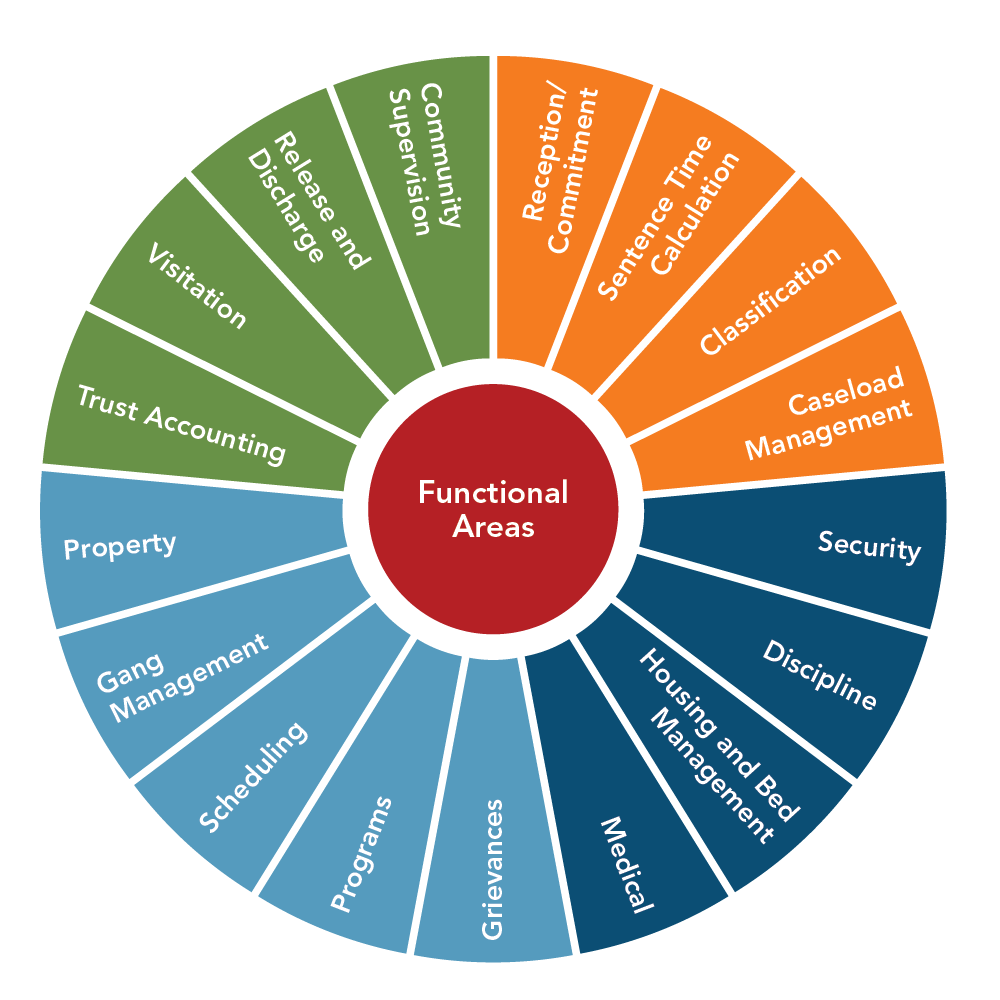How Does Change Impact Motivation Of Employees
Read this if y'all accept a responsibleness for acquiring and implementing victim notifications for your jurisdiction.
In the first article of this three-part serial we explored the challenges and risks associated with utilizing multiple victim notification systems across your state, while the second focused on exploring what the choices are to address these challenges. In this final installment, nosotros demystify the process of developing requirements for a victim notification system. Here are some things to address when developing requirements:
- Considering all of your victim notification stakeholders and their specific needs
- "Mining" requirements from your current victim notification system to ensure that your electric current needs are met in the future system
- Determining what the market can support (and what it tin can't)
- Utilizing standards to increase the likelihood that market place solutions, designed based on these standards, will run into the needs of your jurisdiction
Understanding the needs (and wants) of your stakeholder group is critical to defining a successful gear up of requirements that meets your specific needs. Representative stakeholders may include:
- Victim advocacy groups (both regime run and individual sector)
- Police and sheriff departments
- Department of Corrections
- The courts
- Probation department
- Prosecutor offices
- The victims themselves
Of grade the stakeholder group in your jurisdiction may differ, and the needs of these groups will as well differ. For instance, victims and advocacy groups are concerned almost ease of use, accuracy, and timeliness of notifications. Police and sheriff departments may be concerned virtually ensuring they are meeting their statutory and moral obligations to notify the victims when offenders are released from custody.
Since these groups have varied needs, it's important to engage them early and throughout the requirements development procedure. Talk to them, observe their practices, and review their electric current systems. It'south possible, for example, that it's important that sheriff departments tin integrate their jail management system to the replacement victim notification system and the integration creates a seamless and timeline notification process when an offender is processed out of jail and into the customs. Considering the Department of Corrections is designed to concur offenders for a longer menstruum of fourth dimension, the department may require that their offender management system triggers an alert to victims when pre-release planning activities begin.
Scaling victim notification systems
Utilization of victim notification systems tin also include a wide spectrum; from a unmarried jail engaging with a victim notification organization vendor to provide specific notification services, to a statewide victim notification arrangement that provides these services for the larger stakeholder group. Because of this, your requirements must reflect that "scale." Consider the utilization of the arrangement earlier developing your requirements so that y'all don't over (or under) engineer the organisation for your jurisdiction.
As mentioned in the second article in this series, there are many victim notification arrangement options to consider, from dwelling-grown applications to turnkey software as a service (SaaS) services. Regardless of the path you cull, consider leveraging the victim notification system standards as defined by the Department of Justice (DOJ) Bureau of Justice Assistance (BJA SAVIN Guidelines). These guidelines and standards are terrific sources for victim notification system requirements, and can be thought-provoking as y'all engage your stakeholder groups.
Though these standards are extremely useful, be certain to identify and include any jurisdiction-specific needs in your set of requirements. They may exist driven by state statutes or by local policy or procedure. In defining your unique requirements, but ask, "Why are they important? Were they divers based on processes put in place because you lot don't take a stiff victim notification organization, or are they critical to satisfying statute or policy?"
Stakeholder advice and engagement
Once you develop a preliminary set of requirements, it's important to see with the stakeholder groups to refine and prioritize the requirements. This exercise will result in a clear and concise set of requirements that are understandable by victim notification system vendors that may be responding to the resulting solicitation. When defining the requirements themselves, we find it useful to follow the guidelines from the Establish of Electrical and Electronics Engineers, Inc. (IEEE) called "IEEE Recommended Practice for Software Requirements Specifications." Co-ordinate to the IEEE standard, good software and hardware requirements should be:
- Correct
- Unambiguous
- Complete
- Consequent
- Ranked for importance
- Verifiable
- Modifiable
- Traceable
Prioritization of the requirements also helps responding vendors understand which requirements are most important to your jurisdiction. This prioritization model can also be used when scoring the vendors' responses to the requirements one time proposals have been received.
Conclusion
In summary, it is of import your victim notification system requirements reflect the needs of your stakeholders, are realistic, and articulate. Vendors will be asked to answer to how they can adapt the requirements, then using the IEEE method described higher up tin exist useful.
Though this article doesn't dive securely into the development of the request for proposals (RFP) for the victim notification organization, beneath are some actions to take to improve your chances for a successful system option project:
- Define a meaningful project telescopic to scale the vendor market
- Assign a balanced evaluation committee with impartial scoring criteria
- Craft a structured procurement package that attracts multiple vendors
- Design a reasonable and achievable RFP schedule of events
- Reduce ambiguity and increasing clarity of RFP terms
If you take questions about your specific situation, please contact our Justice & Public Rubber consulting team. We're here to help. The BerryDunn team has developed a mature methodology for determining victim notification system requirements, and has a rich repository of requirements to start with so that you don't need to start from scratch.

Article
Victim notification arrangement requirements: It's easier (and harder) than you think
Read this if you take a responsibleness for acquiring and implementing victim notifications for your jurisdiction.
In the first article of this three-part series we explored the challenges and risks associated with utilizing multiple victim notification systems across your land. In this article we will explore what the choices are to accost these challenges.
System elements to consider
Many jurisdictions are under the impression that there are only one or two choices for victim notification systems. Though there are certainly market leaders in this space, you should select a arrangement model that best meets your jurisdiction's contour. The profile may include some of these elements:
- Take chances disfavor (i.e., How risk averse is your organization regarding system implementations?)
- Upkeep (i.e., How volition the initial project exist funded? Does your jurisdiction prefer an annual subscription model, or a traditional perpetual license with annual maintenance and back up fees?)
- Staff (Who practise y'all need to implement and maintain the operational system?)
- Time (i.e., Are you already out of compliance with state statutes?)
- Hosting environment (i.eastward., Do yous desire to host in the cloud or on premise?)
- Victim notification achieve (i.eastward., state-wide, single jurisdiction, multiple justice partners)
- Victim notification policy and statute complexity
- Data ownership (i.e., To what degree does your jurisdiction enable the selling of victim notification data exterior of the jurisdiction?)
Victim notification solutions range from hosted commercial off the shelf (COTS) solutions, which are typically least expensive; to custom solutions developed to accost jurisdiction-specific needs. The latter tend to be more expensive, riskier than turnkey solutions, and take longer to operationalize. Nevertheless, if your jurisdiction has unique requirements for victim notification, this may be a viable selection. Unless y'all plan to engage the evolution vendor in a long-term contract for maintenance of this type of system, yous must consider the impact on your existing IT staff. "Platform" solutions are a hybrid of COTS and custom evolution. With these solutions, there is typically a platform (i.east., Client Relationship Management or CRM) on which the victim notification arrangement is developed. Using a platform de-risks the development of the application'south architecture, may be a slightly less costly approach, and may simplify the maintenance of a arrangement that is addressing unique requirements.
You lot may also already have licenses for victim notification capabilities, and non even realize it. Some offender direction systems (OMS), jail management systems (JMS), and fifty-fifty prosecution systems (that back up victim advocacy functions) may have built-in victim notification functionality included for the licensing price you are currently paying, or may include the selection to buy an improver module.
Advantages of using victim notification capabilities packaged with an existing system may include:
- Lower conquering and maintenance costs
- Tighter integration with the OMS, JMS, or prosecution organization may issue in more seamless utilization of offender and victim information
- You lot take a single contract, with a single vendor, reducing contract direction overhead
A likely disadvantage, all the same, is the victim notification functionality may not exist a robust as a indicate solution, or custom-built system. Additionally, if the "achieve" of the JMS is a single county, and then victim notification capabilities built into your JMS may not suffice for statewide use. Nevertheless, if the congenital-in functionality meets your needs, then this is certainly a viable path to consider.
Every bit mentioned in the start commodity, regardless of your approach the integration between your victim notification arrangement and the JMS, OMS, prosecution system, and court organisation is critical to reducing back-up and increasing the timeliness with which both offender and victim data is entered into the victim notification system―and used to trigger the notifications themselves.
Determining the best selection for your victim notification organisation
And so how do you decide which choice is all-time for your jurisdiction? The beginning step is to determine your jurisdiction'south risk profile versus the need to for jurisdiction-specific functionality.
Mature market-based solutions are typically less risky to implement, since multiple jurisdictions are likely successfully using them to support their victim notification operations. However, these solutions may non exist customizable or flexible enough to address your specific needs.
"Build" models (using platform solutions or other application development models) tend to exist a bit more than risky (equally many "from scratch" development projects can be); notwithstanding these are more likely to address your specific needs. Hither are a few questions that you should ask before making a determination betwixt a COTS solution and a custom-build:
- Exercise we really have jurisdiction-specific victim notification needs?
- Tin a COTS solution encounter the statutes and policies in our jurisdiction?
- How risk-averse is our jurisdiction?
- Do we take time to develop a customized solution?
- Practice we have the talent and chapters to maintain a custom solution?
Budget considerations
The next pace is to determine your upkeep. We recommend you assess a budget over a x-year total cost of ownership. The cost of a traditional, perpetual license-based COTS solution, including initial conquering and implementation, will be college in the first few years of apply, merely the ongoing almanac fees will be lower. The cost of a custom-build solution will be fifty-fifty higher in the kickoff few years, just annual maintenance should drop off dramatically. The cost of a subscription-based COTS solution will be relative fifty-fifty yr over yr. All the same, if you model these costs over 10 years, yous volition have a reasonable sense for how these costs trend (i.e., the cost of a subscription-based model will likely be higher over 10 years than the perpetual license model).
The other consideration is how you program to fund the system. If there are capital funds in the budget for initial conquering and implementation, this may benefit the perpetual license model more than the subscription-based model. Regardless of the funding approach, you will likely be using the selected victim notification method for a significant menses of time, so don't settle.
Finally, determine how to acquire the arrangement (or systems integration vendor that volition assist you lot develop the system), which is the bailiwick of the third article in our series.
If you have questions nearly your specific state of affairs, please contact our Justice & Public Safety squad. We're here to help. To larn more about other choices in victim notification procedures and systems, stay tuned for our third article in this serial where we explore the process (and pitfalls) of procuring a statewide victim notification arrangement.

Commodity
Victim notification systems: What choice do yous have?
Read this if you lot accept a responsibleness for victim notification.
Is your state complying with state and federal victim notification organization statutes? How practice yous know if you are (or aren't)? The federal government passed the Victims' Rights and Restitution Act in 1990. This human action requires all federal constabulary enforcement officers and employees to make their all-time efforts to accord victims of crime with the right to exist notified of offender status changes (i.e., motion from incarceration to the community). All states have similar statutes; many are more prescriptive and specific to each land.
You lot may be thinking "we accept implemented a victim notification system, we're all gear up." To be sure, information technology'southward all-time practice to ask yourself these questions:
- Does my country use multiple victim notification systems, perchance one for the Department of Corrections, and others in use for jails, courts, or past the prosecutor'due south office?
- Practise victims sympathise how to register and use the system(southward)?
- If yous have multiple systems in use across your state, do victims know they must register in each (bold that the offender is nomadic)?
- Are the systems interfacing with the victim notification organisation to provide real-time updates regarding offender status changes and movements, or is the information reliant on human entry alone?
- Is there redundancy in your victim notification approach? Are yous relying solely on the victim notification organization for statutory compliance, or are at that place other measures in identify?
- Accept yous divers the term "victim" in your country? How do you lot distinguish "known victims" from "interested parties"? Are these 2 groups treated equally in your victim notification systems and processes?
Every bit we take explored these questions with various corrections clients, we've found that states address them in unique means. In many cases, initial information regarding victims is captured on a pad of paper; in some, that information is never transposed into electronic form. Smaller, rural jails are more inclined to manually reach out to victims in their tight-knit communities, while jails in larger jurisdictions may non accept the capacity to do so, and rely much more heavily on automation to comply with victim notification requirements.
Many states employ multiple victim notification systems (jails may utilise one arrangement, while prisons utilise some other), without integrating them to share data nearly offender movements and victim registrations. This results in a gap of service to victims likely unaware of the ramifications of having multiple, disparate victim notification systems. Many mature victim notification systems have the ability to interface with systems such every bit offender management systems (typically managed by the state's section of corrections), jail direction systems (typically managed by each county sheriff'south role), prosecution systems, and others.
These system integrations are critical to reducing back-up and increasing the timeliness with which both offender and victim data is entered into the victim notification system and used to trigger the notifications themselves.
Then how can you lot assess your processes? The get-go step is to decide if your country has a trouble with, or compliance gap between current practices and victim notification statutes. Here are some steps yous can take to assess your state of affairs:
- Review the victim notification statutes in your land
- Inventory the victim notification systems in apply across your land, including any interfaces that may exist with the systems described earlier
- Talk to victim advocates to acquire more about how they utilise the systems to augment their efforts
- Connect with representatives within your state section of corrections, sheriff'due south offices, prosecutors, courts, probation, and other groups that may be providing some level of victim advocacy and larn more nigh their concerns
If this is all overwhelming, endeavor and have it ane stride at a time. Yous tin can likewise engage a professional person consulting firm that can assist you organize and systematically assess the trouble, so collaborate with y'all to develop a plan to close the gaps.
If you have questions about your specific situation, please contact our Justice & Public Safety squad. Nosotros're hither to assistance. To learn more about other choices in victim notification procedures and systems, stay tuned for our second article in this series, where we explore options for acquiring and implementing a statewide victim notification arrangement.

Article
Risky business: Multiple jurisdictional Victim Notification Systems
Read this if yous utilise, manage, or procure public safety and corrections technology.
Recently we discussed the benefits of developing a strong, succinct Request for Proposal (RFP) that attracts Offender Management Systems (OMS) vendors through a competitive solicitation. Conversely, nosotros explored the advantages and disadvantages of leading a non-competitive solicitation. Industry standards and best practices serve as the common thread betwixt competitive and non-competitive solicitations for standard implementations. So, how does an bureau ready to navigate the nuances and avoid the "gotchas" of a non-standard implementation in the corrections realm?
Functional areas in the corrections industry exist in an e'er-evolving state. The ongoing functional expanse refinements serve to overcome potential gaps betwixt standardizing organizations (e.grand., CTA, APPA) and your bureau's operations. For instance, CTA does not distinguish incidents from disciplines as distinct functional areas. While merging workflows for incidents and disciplines may align with i agency'south practice, your agency may not e'er correlate the two functions (east.1000., disciplinary action might non ever result from an incident). Moreover, your bureau may not have a need for every functional area, such as customs corrections, depending on the scale of your operation.
Your agency should view the industry standards as a guide rather than the source of truth, which helps yous cultivate a less parochial arroyo driven solely by standards and follow instead a more pragmatic plan, comprised of your unique operations and all-time practices. CTA and APPA specifications lonely volition result in comprehensive solicitation. For that reason, agencies tin enhance an OMS modernization initiative by enhancing solicitation requirements to include jurisdictional specifications resulting from interviews with end-users and policy inquiry.
Upcoming OMS webinar
On Thursday, Nov 5, our consulting team will host a webinar on navigating a solicitation for a new OMS. During the webinar, our squad volition revisit the benefits of an contained third-political party on your solicitation and review industry standards, and volition discuss:
- Crafting requirements that address common OMS functions, as well as jurisdiction-specific functions (i.e., those that address the unique statutes of the state). Crafting requirements helps your agency to ensure a replacement system addresses core business functions, provides a modern technical infrastructure, and complies with local, land, and federal regulations.
- Thriving with a collaborative approach when acquiring and implementing an OMS system, helping to ensure all stakeholders not only participate in the project simply also buy into the disquisitional success factors.
If you have questions nearly your specific state of affairs with OMS implementations, or would like to receive more than information about the webinar, delight contact one of our public safety consultants.

Article
Managing non-standard Offender Management System (OMS) implementations
Read this if you utilise, manage, or procure public safety and corrections engineering.
In our previous postal service, we discussed the link between developing a engineering science RFP with meaning, structure, and clarity to enhance the competitive nature of the solicitation. In this article, we ask: How tin can your agency synthesize and unify existing business organization processes with manufacture standards to attract modern OMS providers? The answer? Your agency crosswalks.
Industry standards, such equally those fix by the Corrections Technology Association (CTA) and American Probation and Parole Association (APPA), establish the benchmark for modern operations. Nevertheless, legacy correction software limitations often blur the ane-to-one human relationship with manufacture standards. For that reason, crosswalk tools help agencies map current procedure into industry-broad standards.
CTA Functional Areas

Agencies crosswalk in preparation for a corrections technology procurement to assist align system requirements with commercial-off-the-shelf (COTS) corrections management systems. In revisiting the topics of clarity, pregnant, and structure, the crosswalk helps technology vendors sympathise your electric current operations, the tools your currently use to support the operations, and the mode in which those operations relate to manufacture functional areas.
In an iterative style, the CTA crosswalk first helps you understand your agency'southward technology and operational structure, and so communicates system requirements to correction technology providers in an industry-led framework. The approach helps you lot transition from your legacy processes to your new operational environs.
Although your bureau can engage the market place with a meaningful, structured, and articulate RFP, prequalification and contract vehicles provide a feasible alternative of enhancement to procuring a new offender management system. The following advantages and disadvantages tin inform your agency's decision to use a prequalification vehicle.
Advantages:
- Non-competitive procurement can often be achieved more quickly given the absence of the timeframe normally dedicated to the development of the RFP, posting to potential vendors, and evaluation of proposals.
- Reduced uncertainties in terms of what a vendor is able to provide since an open dialog starts immediately.
- Competitive procurement (secondary contest) under a contract vehicle is limited to the vendors who proposed and were awarded. Merely higher performing vendors are likely to exist able to respond, specially if simply certain vendors are selected from the listing.
- Potentially ameliorate pricing as a vendor can eliminate unknowns through open advice, so less risk is priced into the proposal.
- A better environment around requested changes, as a vendor that has maintained a certain margin in their pricing may be more acquiescent to no-price change orders.
Disadvantages:
- The bureau loses some negotiating advantage when a vendor knows they are the simply ones in the procurement conversation.
- A vendor may have less incentive to "put their all-time human foot forward" and offer college levels of service and functionality.
- Competitive cost may not be obtained because the vendor doesn't accept to worry almost beating a competitor.
- Secondary competition may accept a somewhat similar timeframe because the solicitation, evaluation, and honor processes have a similar corporeality of time to an RFP for larger projects.
The trajectory to develop an RFP for new corrections direction software spans assessing existing operations and technology to including mapping current operations into industry standards clarity. At the same time your agency should consider the driving and constraining factors for using a prequalification or contract vehicle.
BerryDunn has experience with cross-walking agencies into industry-leading practices, and we likewise understand the demand for non-standard RFPs that extend beyond CTA and APPA guidelines. Attain out to our public safety consultants if you lot have questions, or look out for our next weblog providing insight on adapting to and overlapping challenges in non-standard corrections technology procurements.

Article
Leveraging industry standards to optimize Offender Direction Systems (OMS)
Read this if you use, manage, or procure public safety and corrections engineering science.
When initiating the selection of a new technology platform to replace legacy software, how does an agency ensure the new system addresses functional and technical requirements while as well complying with procurement standards? Request for Proposals (RFP) serve as an effective purchasing vehicle, particularly when agencies seek to place modern engineering science with professional person services to implement the software. While correctional agencies may use an RFP to engage a new Offender Management System (OMS) provider, the complexities of the manufacture and vast range of all-time practices complicate the planning, scoping, issuance, and evaluation process.
With the long-term vision set to complete projects on time, under budget, and within scope, contained 3rd-parties write technology RFPs to heighten traceability and accountability during implementation.
An contained third-political party can assist your agency:
- Ascertain a meaningful project scope to scale the vendor market and guide quality proposals
- Develop effective forms, worksheets, and attachments to supplement RFP requirements to back up compliance and meet proposal standards
- Build a balanced evaluation committee with impartial scoring criteria to correspond bureau-wide needs and adequately rank vendors
- Craft a structured procurement package that attracts multiple vendors to find the solution that best fits your needs
- Design a reasonable and achievable RFP schedule of events to stop the project in a timely style
- Reduce ambiguity and increase clarity of RFP terms to streamline the process
If your agency incorporates a audio strategy to craft a meaningful RFP, and then a lengthy, meandering procurement journeying will become a well-defined, objective, and seamless procedure to place new software. Furthermore, you can raise competitive responses with an RFP complimentary from ambiguity―and full of clarity.
If your corrections agency does engage exterior help to facilitate development of an RFP for new OMS software, yous should ensure that the third party you engage has feel supporting a meaningful, balanced, and structured purchasing process. BerryDunn injects all-time practices from the Corrections Technology Association (CTA) and American Probation and Parole Association (APPA). Pairing CTA and APPA standards with an RFP tailored to the engineering science markets will help an agency boost vendor responses to ultimately improve critical operations.
Reach out to our public safe consultants directly for questions, or look out for our next weblog providing insight on leveraging industry standards (e.1000., CTA, APPA) when crafting an RFP for corrections technology.

Article
Sourcing new It systems: Tertiary-party advantages
Law enforcement, courts, prosecutors, and corrections personnel provide many complex, seemingly limitless services. Seemingly is the key word here, for in reality these personnel provide a set number of incredibly important services.
Therefore, it should surprise no one that justice and public safety (J&PS) It departments should as well provide a well-divers set of services. Even so, these departments are often viewed as parking lots for all technical bug. The disconnect between IT and other J&PS business units ofttimes stems from differences in organizational culture and structure, and differing section objectives and goals. As a outcome, J&PS organizations oftentimes feel misperception between business units and Information technology. The solution to this disconnect and misperception? Defining IT section services.
The benefits of divers IT services
- Increased business customer satisfaction. One time Information technology services marshal with customer needs, and expectations are established (e.thousand., service costs and service level agreements), customers can expect to receive the services they agreed to, and the IT department tin align staff and skill levels to successfully come across those needs.
- Improved Information technology personnel morale. With clear definition of the services they provide to their customers, including conspicuously defined processes for customers to request those services, It personnel will no longer be bailiwick to "rogue" questions or requests, and customers won't exist inclined to circumvent the procedure. This decreases Information technology staff stress and enables them to focus on their roles in providing the defined services.
- Better alignment of IT services to organizational needs. Through collaboration between the business and Information technology organizations, the business is able to conspicuously articulate the IT services that are, and aren't, required. Information technology tin can help ascertain realistic service levels and associated services costs, and tin can marshal IT staff and skills to the agreed-upon services. This results in increased IT effectiveness and reduced defoliation regarding what services the concern can expect from It.
- More collaboration between IT and the system. The collaboration betwixt the IT and business units in defining services results in an enhanced human relationship betwixt these organizations, increasing trust and clarifying expectations. This collaborative model continues as the services required by the business organisation evolve, and IT evolves to support them.
- Reduced costs. J&PS organizations that neglect to strategically align IT and business strategy face increasing fiscal costs, as the organization is unable to invest It dollars wisely. When a business organisation doesn't run across IT as an enabler of business strategy, Information technology is no longer the provider of choice—and ultimately risks IT services existence outsourced to a third-political party vendor.
Next steps
In one case a J&PS It department defines its services to support business needs, information technology and so can align the Information technology staffing model (i.east., numbers of staff, skill sets, roles and responsibilities), and continue to collaborate with the concern to place evolving services, likewise as remove services that are no longer relevant. Contact u.s.a. for help with this next step and other IT strategies and tactics for justice and public safety organizations.

Article
The definition of success: J&PS Information technology departments must ascertain services
Your government bureau simply signed the contract to purchase and implement a shiny new commercial off-the-shelf (COTS) software to supplant your aging legacy software. The project programme and schedule are set; the vendor is set up to begin configuration and customization tasks; and your team is eager to start the implementation procedure.
You are, in a word, optimistic. Only here comes the adjacent stage of the project—the gap analysis, in which your projection team and the vendor'south project squad test the new software to run into how well it fulfills your requirements. Spending sufficient time and energy on the gap analysis increases the likelihood the resulting software is configured to support the desired workflows and processes of the bureau, while taking advantage of the software'southward features and benefits. Notwithstanding this phase can exist stressful considering it will place some gaps betwixt what y'all desire and what the software tin provide.
While some of the gaps may exist resolved by uncomplicated adjustments to software configuration, others may non—and tin consequence in major bug impacting project telescopic, schedule, and/or cost.How do you resolve these major gaps?
Multiple Methods . Don't let your optimism die on the vine. There are, in fact, multiple ways to address major gaps to keep you on schedule and on budget. They include:
Documenting a change request through a formal change command procedure . This will likely issue in the vendor documenting the results of the new project scope. This, in plow, may touch the projection's schedule and price. It promotes best practise by formally documenting approved changes to projection telescopic, including whatsoever impact on schedule and toll. Still, the change request process may have longer than yous may originally conceptualize, as it includes:
| • | Documenting the proposed alter |
| • | Scoping the change, including the touch on on cost and schedule |
| • | Review of the proposed scope modify with the project team and vendor |
| • | Final approval of the alter before the vendor can begin work |
Collaborating with the vendor on a solution that fits within the confines of the selected software . With no bodily customization required, this may result in a functionality compromise, and may as well involve compromise by the project team and the vendor. However, it does not require a formal process to document and approve a change in telescopic, schedule or toll, since there are no impacts on these triple constraints.
Collaborating with the vendor and internal projection stakeholders to redefine business processes . This may or may non result in a modify request. It also promotes best practice, as the business concern processes become more than efficient, and are supported by the selected software product without customization. This volition require a focus on organizational change management, since the resulting processes are not reflective of the "way things are done today."
Accepting the gap—and doing nothing . If the gap has little or no bear upon on business process efficiency or effectiveness, this method is probable the least impactful on the projection, as there are no changes to scope, schedule, or cost. However, the concept of "doing nothing" to address the gap may have the same organizational change ramifications as the previous point.
Of form, in that location are other methods for addressing major software gaps. The BerryDunn team brings experience in facilitating discussions with agencies and their vendors to discuss gaps, their root causes, and possible solutions. We leverage a combination of project management discipline, organizational change management qualifications, and deep expertise to help clients increase the success likelihood for COTS software implementations—while maintaining their vital relationships with vendors.

Commodity
Grappling with software gaps
As more than state and local government workers enter retirement, country and local agencies are condign more dependent on millennial workers — the largest and almost educated generation of workers in American history. But at that place is a serious gap betwixt supply and need.
Equally noted in a 2016 study by the Bureau of Labor Statistics titled
Household Data Almanac Averages xv, but 25.vi% of current
authorities workers are between the ages of 18 and 35.
This trend isn't necessarily shocking; many millennials choose higher-paying jobs in the private sector over lower-paying jobs in the public sector, especially when the days of a lifelong government career, and generous pensions, are dwindling. Just it is a serious labor problem for government agencies — ane that requires artistic solutions. To entice these new workers, state and local governments need to adopt new recruiting and retaining methods.
Recruiting Methods
While coin matters to millennials, they also want to live a life of adventure, effort new things, embrace trailblazing technology, pursue meaningful goals, and proceeds a sense of both personal and civic accomplishment. In short, these new workers take values that differ from previous generations. You lot can aid entice them by:
- Highlighting your country and local agency's mission and greater purpose. Many millennials want to affect alter and find careers consistent with their values. Include information in your task descriptions near the positive ecology and social touch your agency makes.
- Updating your technology. Millennials take grown upward with applied science (literally at their fingertips), can accommodate to change as no other generation before them, and often strive to remain on the "cut edge." By updating your agency's technology, you volition not but improve your organisation and benefit the public y'all serve, only also accept a ameliorate chance of recruiting the best and brightest millennials.
- Providing them with a piece of work-life residual. Life exterior of piece of work is but every bit important to millennials equally their careers. They don't programme to wait for retirement to finally pursue their interests, and so providing them with a level of flexibility is primal to recruitment. Consider offer flexible workdays, remote working capabilities, extended parental leave, sabbatical opportunities, and "mental wellness days." The more than flexibility state and local agencies provide, the more incentive at that place is for millennials.
Retaining Methods
Recruiting millennials for government jobs is challenging plenty, and retaining them can testify even harder, every bit job hopping is standard practice for many members of this generation. Nevertheless, at that place are sure methods your agency can adopt to prevent millennial turnover. Nosotros suggest:
- Investing in employee evolution and training. Training and creating opportunities for promotion and career advancement are motivating incentives to millennials. Professional evolution excites millennials and investing in them will pay off for the bureau — and the employees will be more engaged and likely to stay.
- Showing employees they are valued. Recognition is the biggest motivator as well money — millennials want acknowledgement for the good piece of work that they do. Communicate achievements and provide awards to recipients in front of their peers. This non only gives them credit, but also motivates others. Continuing to communicate to your employees how their work supports their values reminds them they made the correct determination in joining the public sector in the get-go place.
Brand Your Move
Millennials are worthy of your attending! To compete with the individual sector — to recruit and retain them — your government agency has to accept an innovative approach to capitalize on this ever-growing demographic. If your country or local agency needs help refreshing your technology, reviewing electric current policies and procedures, or taking a fresh look at your processes, contact BerryDunn. We would beloved to talk about your delivery to your future!
You may too be interested in: CFOs for Hire; How to Concenter and Retain Workers in a Seller's Marketplace

Commodity
Getting millennial with it: How land and local governments tin recruit and retain a new generation of workers
Source: https://www.berrydunn.com/news-detail/change-management-keeping-employees-motivated-during-multiyear-projects
Posted by: duranhishentimed.blogspot.com


0 Response to "How Does Change Impact Motivation Of Employees"
Post a Comment